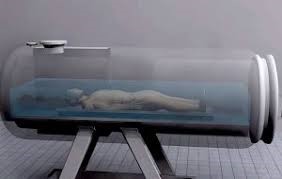As traditional burial and cremation practices continue to dominate the way we handle human remains, an environmentally friendly alternative known as aquamation is gaining traction. Also referred to as alkaline hydrolysis or water cremation, this innovative process offers a greener, more sustainable option for those concerned about the environmental impact of traditional death-care methods.
What is Aquamation?
Aquamation is a process that decomposes the body using water and an alkaline solution, leaving only the skeleton behind. Unlike cremation, which relies on high heat to break down the body, aquamation uses a pressurized vessel filled with a heated solution of water and potassium hydroxide. Operating at temperatures between 200°F and 300°F (90°C to 150°C), the solution breaks down the body’s organic material over several hours, leaving behind only the bones.
Once the process is complete, the remaining bones are dried and processed into a fine white powder, similar to the ashes produced by traditional cremation. This powder can be returned to the family, just like cremation remains.
Environmental Benefits of Aquamation
One of the most compelling reasons for choosing aquamation is its minimal environmental impact. Unlike cremation, which releases harmful gases like carbon dioxide and mercury into the atmosphere, aquamation produces no harmful emissions. Additionally, aquamation uses approximately 90% less energy than cremation, making it a far more energy-efficient process.
The byproduct of aquamation is a sterile liquid that can be safely disposed of in waterways or used as a natural fertilizer, enriching the soil. This makes aquamation an eco-conscious option for those looking to minimize their environmental footprint even in death.
A Notable Example: Archbishop Desmond Tutu’s Choice
Aquamation recently gained significant attention when South African Archbishop Desmond Tutu chose it as the method for his funeral. Known for his advocacy for the environment and his humility, Tutu’s decision to opt for aquamation aligns with his values and represents a growing trend among individuals looking for sustainable end-of-life practices.
This choice not only highlighted the growing awareness of sustainable death-care methods but also sparked conversations about how future generations will handle the environmental impact of traditional burial and cremation practices.
Why Aquamation is Gaining Popularity
With growing concerns about climate change and environmental sustainability, many people are seeking alternatives to traditional death-care practices that contribute to pollution and land use issues. Aquamation offers a solution that aligns with these values by providing an option that is both environmentally friendly and sustainable. As more people become aware of this process, aquamation is likely to continue gaining popularity as a viable and responsible alternative.
Conclusion
Aquamation presents a promising alternative to traditional burial and cremation methods, offering a sustainable, energy-efficient, and environmentally friendly way to handle human remains. With its minimal environmental impact and its potential to reduce harmful emissions, aquamation is a fitting choice for those who want to leave a smaller ecological footprint. As more people turn to eco-conscious practices in life and death, aquamation is poised to become a mainstream option for environmentally aware individuals.



Comments (0)
No comments yet. Be the first to comment!
Leave a Comment